Category: Uncategorized
TEXRail Breaks Ground, 3 Times in One Day
Published in Passenger Transport (August 25, 2016):
A new commuter rail line that will run from downtown Fort Worth to the airport kicked off construction in bold fashion – with three groundbreakings in one day. Trinity Metro’s TEXRail project celebrated at Fort Worth’s historic Texas & Pacific Station, which will be the beginning of the route, as well as in Grapevine and North Richland Hills.
“We are delighted to have this project underway,” said Paul Ballard, president/CEO of the Trinity Metro. “TEXRail is a tremendous achievement for our region and our customers.”
TEXRail’s 27-mile line will go through Fort Worth’s four stations and five others, including two in North Richland Hills and one in Grapevine. Service will begin in late 2018, and more than 9,000 daily riders are expected by the end of the first year of operation. By 2035, that number is projected to grow to 14,000 riders.
Bob Baulsir, vice president of railroads and procurement, said riding TEXRail will be hard to resist. “Once people have the chance to see how smooth and elegant this Stadler vehicle is, they will see that it’s the way to go. Why suffer through white-knuckle driving in traffic when you can sit back and enjoy the ride?”
TEXRail will operate 44 diesel multiple unit (DMU) passenger trains per day. The bidirectional train has the engine in the middle and the operator sits at either end of the DMU.
“One of the greatest features of TEXRail is that we’ll have positive train control for enhanced safety,” Baulsir said. “These trains feature state-of-art technology that will provide a great rider experience.”
Ballard said he is excited for all the project will bring with it. “We have transit-oriented development planned throughout the region, from residential living to retail to boutique hotels,” he said. “Public transportation has a very bright future in North Texas.”
This article was published in Passenger Transport on August 25, 2016.
TEXRail Station Images
TEXRail will have 9 stations along the route from FWTA’s Intermodal Transportation Center (ITC) in downtown Fort Worth to DFW International Airport at Terminal B.
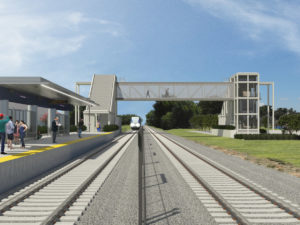
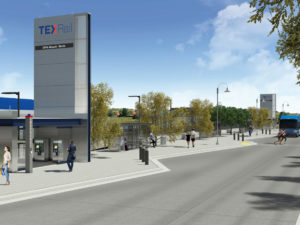
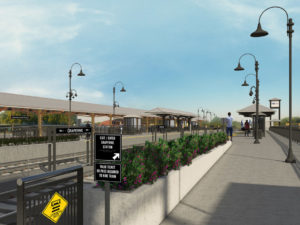
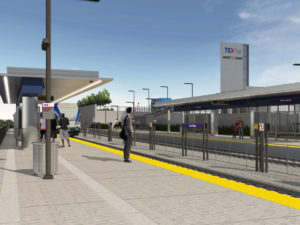
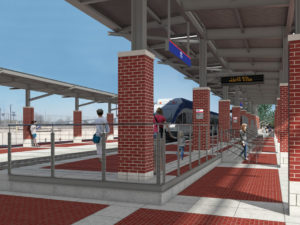
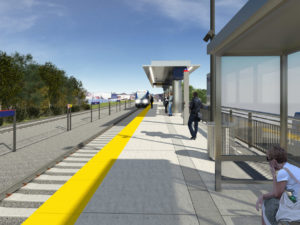
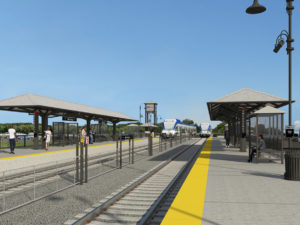
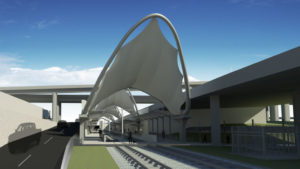
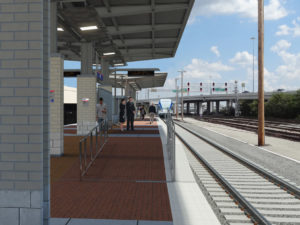
FWTA Gets Greenlight to Start TEXRail Construction
FORT WORTH, TEXAS (June 27, 2016) On June 27, the Federal Transit Administration awarded a Letter of No Prejudice (LONP) to Trinity Metro for TEX Rail, which means that construction for the 27-mile commuter rail can break ground in July. The LONP authorizes Trinity Metro to proceed with procurement of all materials and construction activities planned for the first six months. “We are delighted to receive the Letter of No Prejudice,” said President/CEO Paul Ballard. “We can now secure the prime contract and all subcontracts while locking in current pricing. This has been a long journey and we can’t wait to get started on construction next month.” Bob Baulsir, vice president of railroads and procurement, said the LONP means Trinity Metro can start spending the local funding it has in reserves while awaiting the Full Funding Grant Agreement. “This is a great day for TEX Rail and Trinity Metro – and it’s the beginning of a great rail system that will serve thousands in our region.”
TEX Rail will extend from downtown Fort Worth, across northeast Tarrant County, through North Richland Hills and Grapevine, and into Dallas/Fort Worth International Airport’s Terminal B. The commuter rail line, which will begin service in late 2018, is projected to serve more than 8,000 daily riders at nine stations by the end of the first year of operation. By 2035, nearly 14,000 daily riders are projected to ride the system.
Fort Worth Transportation Authority Commemorates TEXRail Milestone with Rail Agreement Signing
FORT WORTH, TEXAS (December 17, 2015) Representatives of five agencies signed an historic rail agreement today related to the TEX Rail commuter rail, slated to begin service in 2018.
Trinity Metro’s President & CEO Paul Ballard introduced TEX Rail agency representatives after the historic signing of agreement for the TEX Rail commuter rail project partners. These representatives flew from across the country to meet at the Intermodal Transportation Center in downtown Fort Worth to signal their cooperation that will be “the envy of the rest of the country” according to Ballard.
The focus was the celebration of railroad partners: Fort Worth and Western Railroad, Dallas Area Rapid Transit, Union Pacific Railroad and Amtrak. Each railroad’s representative acknowledged the unprecedented level of cooperation and the very real and positive benefits for their customers and constituents.
Ballard thanked these “partners” who have worked to reach this point, including federal, state and local partners, as well as consultants, engineers, builders and other private partners.
“Ultimately, the citizens who have strongly supported the project through the public involvement process since Day One are the real beneficiaries,” Ballard said.
Rail agreement signing lauds TEXRail milestone
Partnership was the reason, and rail transit was the focus of a Thursday meeting where representatives of five agencies signed a agreement related to the TEXRail commuter rail plan.
Service is expected to begin in 2018.
Fort Worth Transportation Authority’s president and CEO Paul Ballard introduced TEXRail agency representatives after he and several officials signed the agreement for the TEXRail commuter rail project partners.
The representatives flew from across the country to meet at the Intermodal Transportation Center in downtown Fort Worth to signal their cooperation that will be “the envy of the rest of the country” according to Ballard.
The ITC is one of the 10 stations where rail vehicles will operate when TEXRail service begins in 2018 from downtown Fort Worth, northeast across Tarrant County to Grapevine and into Terminal B at Dallas/Fort Worth International Airport.
The focus of Thursday’s gathering was the celebration of railroad partners: Fort Worth and Western Railroad, Dallas Area Rapid Transit, Union Pacific Railroad and Amtrak. Each railroad’s representative acknowledged the level of cooperation and what they consider positive benefits for their customers and constituents.
“Ultimately, the citizens who have strongly supported the project through the public involvement process since day one are the real beneficiaries,” Ballard said.
Article on FW Biz Press by A. Lee Graham – Fort Worth Business
Railroads sign TEXRail agreements as project gains federal funds
FORT WORTH
Of all the problems that have plagued efforts to develop the TEXRail commuter line during the past decade, a lack of permission from four railroads to use their tracks was the most pesky.
That hurdle was eliminated Thursday when representatives of the rail companies gathered in Fort Worth to sign eight agreements that collectively clear the way for Trinity Metro to begin operating TEXRail from downtown to Grapevine and Dallas/Fort Worth Airport, possibly by late 2018.
Article on Star-Telegram by Gordon Dickson – Fort Worth Star-Telegram
Cities counting on new ‘villages’ for retail success
“Urban villages” aren’t just urban anymore.
New mixed-use developments in downtown Arlington and North Richland Hills will combine both retail shops and residential living, helping drive business success.
A $70 million development in North Richland Hills, Iron Horse Village, even includes a planned transit station on the TEX Rail commuter line from Fort Worth to DFW Airport.
Developers say the village will include 257 apartments in the first phase, all marketable to downtown commuters or frequent travelers.
The first floors of the four-story buildings are designated for small neighborhood shops or restaurants — the kind of “walkable” local retail found in mixed-use centers in Fort Worth or Dallas.
Arlington’s $49 million 101 Center is expected to break ground this month, bringing six floors of shops and apartments to a complex on the site of the old downtown library.
It’s the first city-style mixed-use center in Arlington, bringing downtown the kind of night and weekend traffic familiar from Dallas’ Uptown or Fort Worth’s West 7th.
Developers say the project will include 221 apartments, including “live-work” units providing small home offices adjacent to apartments.
Southlake Town Square is in its own building boom, expanding with a six-story office building, 30 larger brownstone homes and 36 $1 million condominiums.
Sales tax receipts show steady growth across Tarrant County, defying logic amid the local jobs downturn reported Friday by the Federal Reserve Bank of Dallas.
August data show that the Fort Worth-Arlington area has lost jobs through the first eight months of 2015, primarily because of the collapse of oil prices and the decline in fracking in the Barnett Shale.
While Fort Worth-Arlington has lost 2,300 jobs, the Dallas area has added 48,700 jobs, mostly due to growth in business and professional service companies.
Yet many Tarrant County cities are seeing sales tax growth of 5 percent or more, indicating that the energy losses may be offset.
Continued growth at Lockheed Martin Aeronautics would help even more. The company says the F-35 program is already driving 10,000 jobs at 73 North Texas suppliers, and supporting 28,000 indirect jobs.
Even with recent job losses, the announcement of major new retail-residential developments is a positive sign.
There is plenty of reason for developers to remain confident in the future growth and success of Tarrant County and North Texas.
Article on Star-Telegram, Editorial — Fort Worth Star-Telegram
Mixed-use development planned around North Richland Hills TEXRail station
NORTH RICHLAND HILLS:
A mixed-used development aimed at young professionals and akin to the booming West Seventh Street corridor in Fort Worth is in the works for the area near a planned rail station.
Sitting north of the recently completed North Tarrant Express project and running parallel to the Cotton Belt rail line, Iron Horse Village will eventually include 469 high-end apartments, though initially 257 apartments will be built in the first phase, said Robin McCaffrey, an architect and planner who is coordinating the project for Dallas-based developer Dan Smalley.
Iron Horse Village will be part of a 100-acre development plan that will be divided into sections, city planning manager Clayton Comstock said. Comstock said once the multifamily developments are built, “retail will come naturally.”
Another section is mostly commercial and could feature office buildings up to 10 stories high in an area fronting Loop 820/North Tarrant Express. That area now houses a Sam’s Club, WalMart and other big-box retailers.
City officials hope that the option to redevelop that section into office towers will prevent businesses from just leaving empty big-box buildings should they ever leave their present site.
Called a “transit oriented development,” the estimated $70 million project will play off a planned station for the TEXRail commuter rail that will link downtown Fort Worth and Dallas-Fort Worth Airport. The apartment complex will be a few hundred yards from the rail station and within walking distance of shops and restaurants in North Richland Hills, Tarrant County’s third largest city.
“I don’t actually have to own a car if I don’t want to,” McCaffrey said. “Only a few places can offer that capability.”
The train station is expected to open in 2018 when the rail line begins service. Other stations are planned for Fort Worth, Grapevine, Haltom City, Dallas/Fort Worth Airport and the Smithfield neighborhood of North Richland Hills, according to the Trinity Metro, which is overseeing TEXRail.
The first floors of the buildings in Iron Horse Village will be marketed as business space, but the developer may allow tenants to live there, depending on how quickly restaurants, shops and bakeries move in, McCaffrey said.
The buildings in that section will be limited to four stories, Comstock said.
“Our style is not going to be some sort of retro image of the 1890s,” McCaffrey said. “It’s going to be a more contemporary style structure for the younger, more hip market. I think we can offer everything that they’re looking for.”
Construction is expected to begin in about seven to eight months.
The first apartments should be available in spring 2017.
McCaffrey said he did not know what rents will be, but they will be at least what is being charged in the HomeTown NRH planned development off Boulevard 26.
Apartment owners there charge monthly rents anywhere between about $900 for a 628-square-foot loft apartment to about $3,000 for a 2,400-square-foot, four-bedroom apartment.
The final section, north of the transit area, will be single-family homes, town houses and some businesses, Comstock said.
He said he expects single-family homes to dominate in that section of the development.
Article on Star-Telegram by Gene Trainor — Fort Worth Star-Telegram
TEXRail plans include high-tech approach to safety
FORT WORTH:
A proposed commuter rail line from downtown Fort Worth to Dallas/Fort Worth Airport will be among the first rails in Texas to feature state-of-the-art technology for preventing crashes, an official said.
The TEXRail line, which officials said is on schedule to open by late 2018, will be designed to include a system called positive train control, a Fort Worth Transportation Authority official said.
Project on track
Officials at Trinity Metro are in the final design phase of TEX Rail, and expect to put construction out for bid in December, Baulsir said.
The agency is on track to receive a full-funding grant agreement from the U.S. Transportation Department to pay for up to half the estimated cost of nearly $1 billion in the first quarter of 2016, he said. A full-funding grant agreement is essentially a promise from the federal government to pay a certain sum on a project, although the money can be spread over several years and is subject to approval by Congress.
“We’ve ordered all the rail cars and we’re completing the final design steps now and acquiring real estate along the right-of-way,” said Baulsir. He added that TEXRail will deploy rail cars that are modern and much quieter than those used by the Trinity Railway Express, a service that began in 1996 and now serves downtown Fort Worth to Dallas, following the old Rock Island line through the industrialized Trinity River bottoms corridor.
TEXRail is expected to have about 10,000 riders per day along its 27 miles in its initial year. Demographic modeling shows a good chance of that ridership growing to 15,000 daily passengers, and possibly more, in future years.
The North Central Texas Council of Governments, which helps the T with ridership estimates, has updated numbers showing even stronger job and residential growth in downtown Fort Worth than previously expected, said Dan Kessler, assistant director of transportation.
Getting to work
A handful of residents interviewed at the Intermodal Transportation Center in downtown Fort Worth said they welcomed the opportunity to ride a commuter rail line to a previously underserved area of the county.
TEX Rail will help people who live in central, east, north and south Fort Worth access areas of Northeast Tarrant County where there are lots of good jobs, said Michael Allen, who lives in an apartment near Fort Worth’s historical Stop Six and Meadowbrook neighborhoods.
“We need a train like that,” said Allen, who was waiting for a T bus Wednesday morning to run errands. “A lot of people don’t have vehicles. Some people don’t even known how they’re going to get to the jobs, if they have a job out there. They’ve got to hustle a ride or pay something, and that’s hurting their pocketbooks.”
The complex system, still in development nationwide, uses data from global positioning satellite devices, track-side sensors and other computer technology to determine trains’ locations and watch for human error that can lead to crashes. The system aims to automatically slow down or stop trains as a fail-safe measure to prevent collisions.
After several high-profile fatal crashes nationwide on passenger and freight rail lines between 2002 and 2008, Congress mandated that nearly all rail lines be equipped with positive train control by Dec. 31 of this year. Although railways have been working on the problem for years, those companies have notified the federal government that most of their lines won’t be ready by that deadline.
But the challenge is more manageable for some projects, including TEXRail.
“Basically, it’s a computer system that knows everything about the train — where it is, what it’s doing, how fast it’s going,” said Bob Baulsir, vice president of TEXRail and procurement for Trinity Metro.
“If it’s coming to a curve, it knows the speed limit around the curve, and if the operator is not in compliance with our operating guidelines it’s going to stop the train,” Baulsir said Wednesday, after speaking about TEXRail at a Tarrant Regional Transportation Coalition meeting. “It’s a great way to use GPS and new technology. We’ll be the first in this region to have it.”
Slow, steady progress
The nation’s largest railways, including Fort Worth-based BNSF Railway Co., have said they have made progress in recent years, installing positive train control devices in locomotives, along railroad tracks and in dispatch centers. Even so, the Federal Railroad Administration last month released a report showing that most railroads will miss the deadline.
Railroads are expected to spend several billion dollars installing the hardware and software. In most cases, they must retrofit locomotives and railroad tracks that have been in service for decades.
The TEXRail project can use a portion of a $25 million North Central Texas Council of Governments grant to offset the costs of positive train control.
Article on Star-Telegram by Gordon Dickson — Fort Worth Star-Telegram
